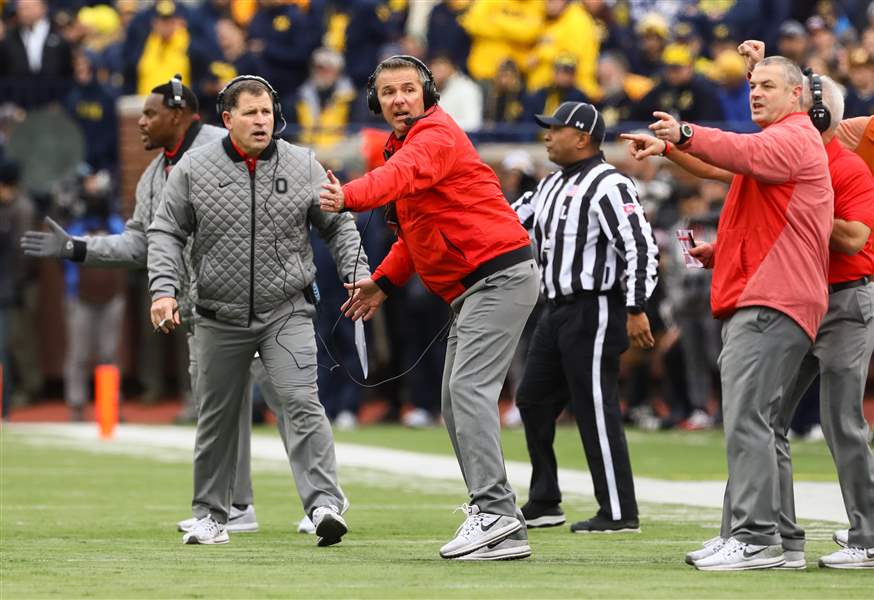
OSU's Meyer is third-highest paid coach ... and he's underpaid
4/10/2018
Ohio State head coach Urban Meyer reacts to a call during a football game against Michigan onNovember 25, 2017, at Michigan Stadium in Ann Arbor, Michigan.
THE BLADE/JEREMY WADSWORTH
Buy This Image

COLUMBUS — Like many of us, Ohio State athletic director Gene Smith thinks college football coaches make too much money.
“The market is way out of line,” he told me this week.
How out of line?
At a recent board meeting, he called new Texas A&M coach Jimbo Fisher’s 10-year, $75 million contract in a different “sphere” — as in circling the drain of sanity.
“That’s not even someone that we’re comparing with because it’s so ridiculous,” Smith said.
Well, know who will earn more than Fisher this season?
Ohio State’s Urban Meyer.
Sure, Meyer’s freshly signed extension runs only through 2022, not the next eon. But just the same, Smith entered into a bargain that is admittedly both — ahem — ridiculous and perfectly sensible, the contract only out of line if our own priorities are too. (Wait, don’t answer that.)
In reality, Meyer is not worth $7.6 million per year, which will make him the third-highest paid coach nationally behind Alabama’s Nick Saban and Clemson’s Dabo Swinney.
He is worth more.
Meyer isn’t just an all-time coach, a three-time national champion who is 73-8 in six seasons at Ohio State. He is the CEO of the university’s prestige entity, the golden-goosed tide that lifts everything from the boats of the crew team — one of 36 varsity sports the football program funds — to the school at large.
Remember, this is not robbing Peter the professor to pay Paul the coach, like in the Mid-American Conference, where student fees and taxpayers subsidize money-losing athletic departments. Ohio State athletics reported $175.9 million in revenue last year, pulling in such a profit that Smith said the department gave $40 million back to the university.
You find the guy who keeps that gravy train rolling — the football coach who furnishes a product that fills your 105,000-seat stadium at Broadway prices and keeps the donations and student applications pouring in — and you shake the money tree bare.
Put it this way: Imagine if Ohio State had hired Minnesota’s Glen Mason instead of Jim Tressel in 2001 or Nebraska’s Bo Pelini instead of Meyer in 2012. Both alums were logical candidates and fine coaches who presumably would have done fine jobs, winning eight, nine, maybe 10 games per year. But if you’ll indulge us, trade your good sense hat for your economist hat. Alabama or Ohio State could pay Saban or Meyer $30 million per year, and, compared to an ordinary Bo doing the same job pro bono, he would be a bargain.
For the handful of blue bloods, the difference between blah and best is worth that much.
“We’re talking about a program here where the expectation is not to be fifth in the country,” Smith said. “It’s to be in the top four and competing for the national championship.”
And that doesn’t come cheap. At the least, Smith knew Meyer had to be the highest-paid coach in the Big Ten, including above Michigan’s Jim Harbaugh, who will earn $7.5 million this season. Harbaugh — for all he has done in reviving UM from its two-Cokes-for-two-tickets depths — earning more than Meyer was like the kids having a bigger allowance than their parents’ paycheck.
“From a performance point of view over time, Urban has performed significantly better than everyone else in the Big Ten, and he needs to be recognized for that,” Smith said. “He wants to be here at Ohio State. He wants to retire at Ohio State. He wants to be here in Ohio. All those things play into this. We have our long-term coach.”
Now, where does the salaries race end? Good question.
The multibillion dollar world of big-time college sports is the Land of Make Believe, where nothing adds up.
We’ve said it before, but consider: Ohio State president Michael Drake leads a top-50 national university. He presides over 60,000 students, 22,000 employees, and a $7 billion budget.
Meyer leads a football team. He oversees about 150 players and coaches and support staffers, and a $38.5 million budget.
Meyer is paid $7.6 million.
Drake is paid $1 million.
The governor is paid $149,000.
The players are paid nothing.
It’s a lot to chew on.
But business is business, and the NCAA politely requests we not ask further questions. Ohio State paid Meyer the going market rate, knowing it will recoup its investment tenfold. For better or worse, the success of the university and its front-porch marquee are inextricably linked. You think Ohio State’s well-documented academic rise happens without a powerhouse football team elevating the quantity and quality of its applicants? Not a chance.
“From the university point of view, if you were to poll 600,000 alums, a super majority of them would talk about their passion around the institution as it relates to football,” Smith said. “The fundraising that exists in different parts of campus because of the esprit de corps that a highly successful football program brings to the culture and atmosphere of our university — it’s massive.
“I recognize that a number of people look at the salary and say that’s ridiculous, and I certainly understand that. The market is out of whack. I’ve always said that, but it is our reality, so we have to look at it. As I tell people all the time, we don’t want to go through a change.”
So Ohio State paid up and the rain kept coming down.
Contact David Briggs at: dbriggs@theblade.com, 419-724-6084, or on Twitter @DBriggsBlade.